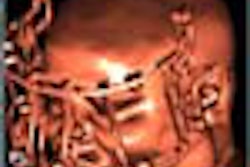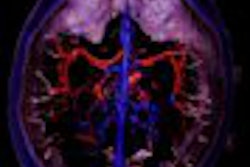When teamed with intracoronary high-resolution imaging, a new 0.032-inch MRI guidewire could be useful in such procedures as vascular gene therapy and balloon angioplasty, according to researchers from Johns Hopkins Medical Center in Baltimore.
Dr. Xiaoming Yang discussed the results of his group’s work at the 2000 RSNA conference in Chicago. In an animal model, the researchers found that they could not only image the arterial wall, but could keep the guidewire within the targeted artery for as long as six hours without any complications.
The guidewire, currently under development by Surgi-Vision of Columbia, MD, consisted of a coaxial cable with an extended inner conductor. Both the shield and the inner conductor were made of nitinol, a titanium alloy.
The implement was first tested with intravascular, high-resolution MRI in five rabbits with normal and atherosclerotic aortas. In a second experiment, 9-French introducers were inserted into the right carotid arteries through arteriotomy. A dose of 100 IU/kg of heparin was administered.
Through the introducer, a 0.014-inch guidewire was delivered with 7-French angiographic catheter assistance into the anterior descending branch of the left coronary artery (LAD) under x-ray fluoroscopy.
After obtaining conventional coronary angiography, the guidewire was replaced with the 0.032-inch MRI guidewire, Yang said. All imaging was performed on a 1.5-tesla Signa CV/i MR scanner (GE Medical Systems, Waukesha, WI) using a breath-hold, ECG-gated technique.
For MRI of the coronary arteries, axial images of the heart were acquired to observe the LAD vessel wall, using a GE cardiac phased-array coil with fast spin-echo (FSE) pulse sequence, 256-pixel matrix, and 3-mm slice thickness. The group then achieved intracoronary imaging with the MRI guidewire in a receive-only mode.
To see the vessel wall, the imaging protocol included FSE (1400/39-msec TR/TE, 10-cm FOV, 62.5 kHz BW), 256-pixel matrix, and 1.5-mm slice thickness with double-inversion to suppress blood signal. Finally, to see vessel wall movement, a fast spoiled gradient echo sequence (FSPGR) was used at an imaging rate of eight frames per second.
According to the results, the vessel wall could be imaged on intravascular MR of rabbit aortas, and the dog or pig LADs. In order to image the latter, the use of the 0.032-inch version allowed the group to decrease the voxel size by a factor of 15.7, compared to imaging with a cardiac coil, Yang reported. On the intracoronary MRI with FSPGR, the movement of the LAD wall and the heartbeat could be seen. Yang added that they did not have any heating problems with inserting the guidewire.
Session moderator Dr. Charles Higgins asked Yang what the advantage was of using MR rather than intravascular ultrasound for this type of procedure. Ultrasound does not allow for visualization of structures behind calcifications, Yang replied.
By Shalmali PalAuntMinnie.com staff writer
June 29, 2001
Click here to post your comments about this story. Please include the headline of the article in your message.
Copyright © 2001 AuntMinnie.com



















